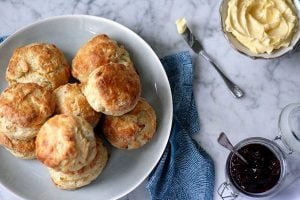Classic buttermilk biscuits are a delicious treat. Quick, easy, and light as a feather, they can be served for breakfast, lunch, tea, dinner and even dessert! The technique is simple, but the results are spectacular.
Here is what you need to know about preparing your own buttermilk biscuits:
Take a flour inventory: When preparing, you will want to use flour that will not get overworked, stay tender, and produce a light-as-air, flaky biscuit. All-purpose flour is your best bet.
Choose your fat wisely: Biscuits can be made with lard but nothing beats butter. The sweet flavor of the butter best complements the natural flavor of the buttermilk. It is recommended to use a high-fat, flavorful one, but whichever you use, make sure it is nice and cold before mixing.
Know your leavener: Many recipes for biscuits use self-rising flour and also add more leavener (usually baking powder). It may seem like a lot, but biscuits are not a time to skimp on it. Aside from the little bit of steam you get from cold butter hitting the heat of your oven, biscuits rely exclusively on chemical leaveners – there are no eggs to make them light and fluffy. Baking powder – a mixture of baking soda (sodium bicarbonate), cornstarch, and a powdered acid – is the most commonly used chemical leavener for biscuits. A generous amount of baking powder is crucial to light, fluffy biscuits – but too much will lend a chemical taste to your final result.
Do not skimp on the buttermilk: Buttermilk is traditionally low in fat, and if there was ever a time to find the good, local product, this is it.
Take a note from pie dough: The process of making biscuits is quite similar to mixing a pie dough: Rub the cold butter into the flour to create shingled pieces of fat throughout the flour. The idea is to create a shaggy, mealy mass with butter pieces ranging from the size of a walnut half to the size of a pea.
Do not roll out the dough: Biscuit dough should be handled as little as possible to keep it tender. Lightly flour your surface and use your hands to shape the dough into a square or rectangle. The most important thing here is the thickness – you want a generous height to begin with to make those gorgeously towering biscuits. Use a floured biscuit cutter to cut out your biscuits and transfer them to your prepared baking sheets.
Take a moment: Chilling biscuits before baking is really helpful. Fifteen minutes in the refrigerator or five minutes in the freezer usually does the trick. Your biscuits will not dramatically suffer if you do not have time for this – they just tend to spread out more, rather than gain vertical height.
Butter or egg wash: Once you are ready to bake, you have got two options for finishing your biscuits: Brush them with melted butter or with an egg wash.
Decide for yourself: If you want pretty, go with egg wash. Or, you can brush them with egg wash before baking, then coat with a bit of melted butter when they first come out of the oven.
Maintain the heat: Biscuits, like pies, breads, and most yeast-risen pastries benefit from a high oven temperature. 218 degrees Celsius is the magic number – it creates steam as moisture evaporates from the butter, creating a burst of leavening straight out of the gate. Plus, the immediate burst of heat is a surefire way to get the best oven-spring from your leavening agent.
Finish with flair: Finish your buttermilk biscuits with a sprinkling of flaky salt after they have been buttered or egg washed.
Recipe
Ingredients
- 5 cups all-purpose flour
- 1 tsp. kosher salt
- 2 tbsp. baking powder
- 1 ½ sticks unsalted butter, cold and cubed
- 2 cups buttermilk
Preparation:
1.Preheat the oven to 218 degrees Celsius. Line two baking sheets with parchment paper.
2. In a large bowl, sift the flour, salt, and baking powder together to combine. Add the cubed butter and toss to coat. Cut the butter into the flour until the mixture forms a shaggy mass, with pieces of butter similar in size to walnut halves.
3. Make a well in the center of the bowl and add the buttermilk. Toss gently to combine the ingredients, taking care not to overmix.
4. When the dough is fully moistened and combined, turn it onto a lightly floured surface. Press the dough into a one inch-thick square. Lightly flour the surface of the dough.
5. Use a floured circle cutter (1 1/2 to 3 inches wide) to cut biscuits. When you have used all of the dough, bring it together and knead it lightly a few times. Repeat cutting biscuits from the dough until all of the dough is used up.
6. Transfer to the prepared baking sheets and refrigerate for 15 minutes. Brush the chilled biscuits with egg wash or melted butter and garnish with a sprinkling of flaky salt.
7.Bake until the biscuits are risen and golden brown. Cool slightly before serving.

















